
| Konrad Ewald Preface to the book «Music for Viola» (4th print) |
At new year's of 2012 I received a kind letter from a violist in Southern Germany; he wrote that he gave himself as a Christmas present a copy of my book (the 2001 edition). He had known for a while that there was someone else working on this subject beside Zeyringer, but «one can anyway find everything in Zeyringer's book (Literature for the Viola)».
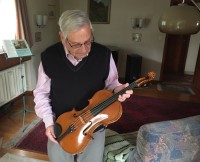
Still another quite different work is the well-documented book «Viola Bibliography» by Michael and Dorothea Jappe. Many - mainly younger - people thought (and even said it): Why is Ewald doing this? We can anyway find everything in the internet. I have no comments regarding this.
The printed book is the fourth (and probably last) version of my Vademecum for Viola players: «Music for Viola», this time with the subtitle «The rich Viola repertoire from Aaltonen to Zytowitsch». There are still publishers and musicians who are talking about the «meager» or «scanty» amount of literature for the Viola. At least for a quarter of a century - the last edition of Franz Zeyringer's «Literature for the Viola» with 446 pages appeared in 1985 - one should and could have known that there are thousands of compositions for and with Viola. But old thinking patterns and wrong views die hard, replicate themselves and are hard to change or eradicate. This holds true not only in the subject of the Viola (a field without any political implications whatsoever), but unfortunately also in all politically relevant areas: Law, Sociology, Sexuality, Psychology, Education...
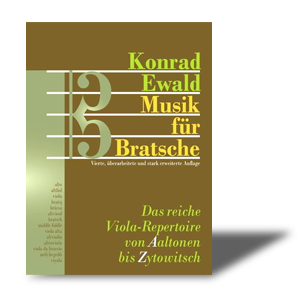 And many wrong opinions are perpetuated by the media and by politicians, instead of being eradicated; I can hardly consider Man to be a mature being. Today the most blatant and disastrous results of such
And many wrong opinions are perpetuated by the media and by politicians, instead of being eradicated; I can hardly consider Man to be a mature being. Today the most blatant and disastrous results of suchunreflected thought patterns and wrong attitudes are the misguided drug policies and the hysteria about terrorism. The majority of so-called intellectuals is also not a whit better than the semiilliterate rest of society. At the age of 75 I give myself permission to make such a presumptuous statement.
But back to music!
To state it right at the beginning: I am not a professional musician. I taught German, French and Latein, got a degree in French philology. Between teaching and making music I read a lot and traveled widely (Greece, African countries, Southeast Asia). At age 18 I switched from the Violin to the Viola in order to be able to play in orchestras and, above all, to play chamber music. Already at a young age I was able to get to know the gamut of the literature for String Quartet (from Haydn and Mozart to Reger and Lauber), thanks to considerably older and more experienced violinists (and my brother as cellist). Additionally I began to purchase compositions for the Viola - and their number multiplied. Buying music is an expensive hobby, and I probably have invested (half) a fortune in scores: I own most of the works reviewed in my book.
It was my goal, already in the first edition of my book, to provide for those interested an overview of the Viola literature. By the «interested» I mean not only the dilettantes, although they were my main target. There is actually an amazing number of professional musicians who know little about the literature of their instrument; because of their orchestral and teaching duties they don't have the time to play and get to know what they would (and should) like to.
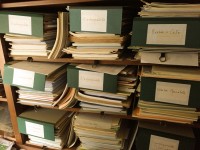
In this context I also must quote the apt saying of Friedhelm Krummacher: «He who refuses to acknowledge other than familiar works, won't know what he's missing». My remarks to the individual works are only meant as [suggestions] (or [warnings]). Don't expect formal analyses. First, I am not qualified for this, and second, the whole book would become too large and unwieldy. My remarks are (subjective) suggestions and (objective) data about the characteristics and difficulties of works. They cannot and don't want to be more. I completely agree with the words of Hans-Heinrich Schmieder: «The short characterisations and playing pointers are of course not meant to be exhaustive... If music publishers, radio stations concert promoters would like to suck some honey from these it would only please me. I am well aware how incomplete, imprecise and subjective these pointers are; but one of the most difficult tasks is to put music into words and descriptions... The intention is only to give suggestions and stimuli to interested musicians».
I stopped listing in the appendix of this (last) edition the (mainly American) composers, whose works
I have been unable to obtain. Many of them have now for me "disappeared". Yet I cannot omit composers like Sally Beamish, Benedykt Konowalski, W.Th. McKinley, Lucia Ronchetti and Katrina Weede (who wrote 15 or more works for Viola) just because I don't know (almost) no works of theirs. One might accuse me of «curling locks on a bald pate» (Karl Kraus said this of an essayist).
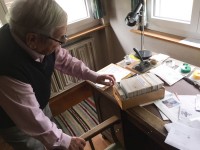
Sometimes I wonder when I hear (or see in the score) a Viola getting tortured (screaming behind the bridge, quintuple forte, not only «col legno» playing, but «col legno sul legno» knocking): Does the soloist play these bonebreaking (or "violabreaking") feats on his expensive Viola masterpiece, or does he may be use a inexpensive student instrument?
I'm also concerned about the insanely high passages in newer works, not just because I cannot reach them myself. The British composer and Viola connaisseur Gordon Jacob has stated: «High passages lie much better on the Violin than on the Viola.» Also look at the works (e.g. the String Trios) of another Viola specialist, namely Alessandro Rolla. He never makes the Viola play in as high a position as the Violin or the Cello.
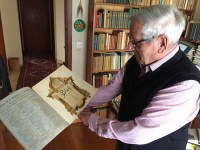
Some Music Information Centers also were very obliging and helpful; they sent me lists when there were no catalogues (Norway, Finland and Sweden have catalogues of chamber music, Finland and Sweden even have a separate catalogue for Viola music).
Special thanks to:
• Australian Music Centre
• Centre for New Zealand Music
• Iceland Music Information Centre
• Ireland Contemporary Music Centre • Ireland Music Publications
• Israeli Music Center
• Scottish Music Centre
• Union of Bulgarian Composers
Dr. Konrad Ewald, Spittelerstrasse 7, CH-4410 Liestal
Mail:
| ABOUT US The 4th printing of Konrad Ewald’s new book «Music for the Viola • The Rich Viola Repertoire: From Aaltonen to Zytowitsch» gave us the impulse for this new project. We are very pleased that Konrad Ewald put at our disposal the copious commentaries to over 8’600 works for Viola; these and further additions are the basis of this new platform. He will continue to collect, discover and discuss more works. www.music4viola.info is the new platform, whose goal is to explore and disseminate in an interactive manner with its users the fascinating repertoire for the Viola. Your opinion is important to us. If you have questions, suggestions, praise or criticism simply get in touch with us. Your music4viola team |
| ABBREVIATIONS IVG - International Viola Society DVG - German Viola Society Hagen - A copy of this works can be found in the library of DVG in Hagen Germany. PIVA - A copy of this works can be found in the library of Primrose International Viola Archive. M - PIVA messages for example M41,35ff. means that it is stated in the notifications 41, page 35 and following. Jb - PIVA yearbooks «The Viola».
Drüner - Music library Dr. Ulrich Drüner. Published or supplied by U. Drüner. Jappe - This particular work can be found on the indicated page in the Viola bibliography by Michael and Dorothy Jappe (Amadeus 1999) and with all Incipits. Labhart - The particular work can be found in the documentation library of Walter Labhart. Locher - Publication by Prof. Klaus Locher. Schmider - Books by Hans Heinrich Schmider. 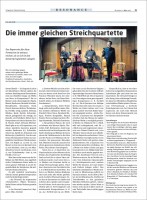
Article in the Swiss Music Newspaper by Konrad Ewald Open access, in German |